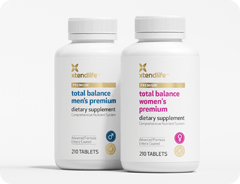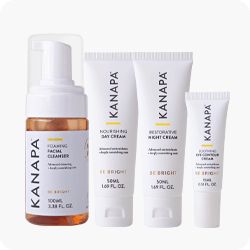Multivitamin supplements most often include vitamin C in the form of ascorbic acid, and although this is a synthetic version of vitamin C and not from food, it is unlike other vitamins in that it is well tolerated by the body, even in its synthetic form.
Even the Linus Pauling Institute – founded by one of the foremost authorities on Vitamin C in the last century – sees no difference between natural and synthetic ascorbic acid.
The two, the organization says, are chemically identical, and studies have shown no significant difference between the two when it comes to absorption. (Ref. 1)
Still, there are a wide range of different forms of vitamin C available in supplements, which likely leads to confusion for consumers. Most supplements offer the nutrient in the form of ascorbic acid, though other forms of vitamin C supplements include sodium ascorbate, calcium ascorbate, other mineral ascorbates, ascorbic acid with bioflavonoids and combination products. For example, our Total Balance Women’s includes Vitamin C in the forms of calcium ascorbate, potassium ascorbate and ascorbyl palmitate, a fat- and water-soluble antioxidant that ensures better absorption in the body. (Ref. 2)
Vitamin C: A tutorial
Vitamin C is a water-soluble vitamin – that means our body doesn’t store it and we need to replenish it daily – and it has long been considered protection from the common cold.
While recent research has determined the vitamin doesn’t prevent colds, it does play a role in wide range of other functions of the body, including protein metabolism, wound healing, athletic performance, and reducing the risk of cardiovascular disease. It is also an important antioxidant that goes to work fighting free radicals that can trigger signs of aging.
“Vitamin C has received a great deal of attention, and with good reason,” said Dr. Mark Moyad of the University of Michigan in an interview with WebMD.com. “Higher blood levels of vitamin C may be the ideal nutrition marker for overall health. The more we study vitamin C, the better our understanding of how diverse it is in protecting our health.”
The recommended daily allowance for vitamin C is 75 to 90 milligrams a day for adults, but when under stress – for many of us, that’s every day as we battle traffic, work harder than ever at our jobs after cutbacks and struggle to balance work, family and leisure time – the adrenal glands immediately turn to vitamin C to counteract the free radical activity that stress stirs up. (Ref. 3)
Given that, consuming more than the recommended daily allowance may prove to be more effective.
But still, there is a fine balance between too much and not enough.
“There is evidence that suggests amounts in excess of 400 to 500 mgs per day could act as a pro-oxidant,” says Xtendlife founder Warren Matthews, though that is more common with ascorbic acid than calcium ascorbate. (Ref. 4)
Our Total Balance formulas contain between 164 and 285 milligrams of vitamin C – above the recommended minimum dose in the United States, but below the 400 milligram or more dosage that has been linked to oxidation.
At Xtendlife, we do not use Ascorbic Acid at all. We only use Calcium Ascorbate, Potassium Ascorbate and Ascorbyl Palmitate, which are more expensive, superior forms of vitamin C.
It also allows for added intake of vitamin C from diet.
Food sources of vitamin C
While citrus fruits have always been considered the gold standard of vitamin C, in reality, some veggies offer more of the nutrient than an orange.
Some of the top providers of vitamin C, in order of nutrient value, include: Red bell peppers, orange juice and oranges, grapefruit juice, kiwifruit, green bell peppers, broccoli, strawberries, Brussels sprouts, cauliflower, cabbage and green peas.
Are higher doses ever warranted?
Despite the dangers of higher doses of vitamin C, there are occasions when elevated levels of the vitamin might be beneficial.
While there is little evidence to suggest that high levels of vitamin C can prevent a cold, a 2000 study from the Australian National University found that high doses of vitamin C – about a gram per day - reduced the duration of a cold.
“There appears to be a modest benefit in reducing duration of cold symptoms from ingestion of relatively high doses of vitamin C,” researchers wrote. (Ref. 5)
If you have any questions about vitamin C or how Xtendlife uses vitamin C, please comment below.
References:
- http://ods.od.nih.gov/factsheets/VitaminC-HealthProfessional/
- http://lpi.oregonstate.edu/infocenter/vitamins/vitaminC/vitCform.html
- http://www.webmd.com/diet/features/the-benefits-of-vitamin-c
- http://www.xtend-life.com/QuestionsandAnswers/Post/11-01-06/About_Vitamin_C_intake.aspx
- http://www.ncbi.nlm.nih.gov/pubmed/10796569


 Supplements
Supplements Superfoods
Superfoods Bundles
Bundles









